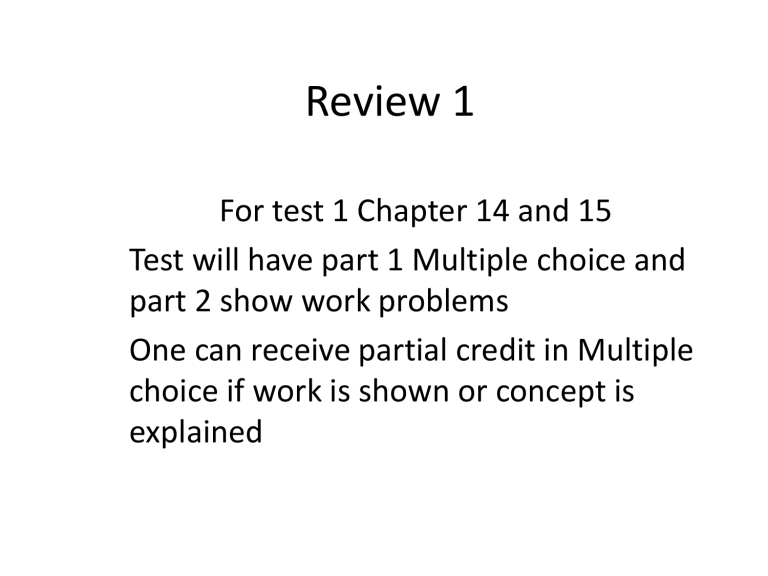Review 1
advertisement

Review 1 For test 1 Chapter 14 and 15 Test will have part 1 Multiple choice and part 2 show work problems One can receive partial credit in Multiple choice if work is shown or concept is explained Concentration Units Molarity (M) moles of solute M = Mole Fraction (X) liters of solution Molality (m) Xi = moles of solute m = moles solute (i) Total moles in solution mass of solvent (kg) Weight (mass) % • Percent by volume: milliliters of solute/milliliters of solution (then multiplied by 100%) • Mass/volume percent: grams of solute/milliliters of solution (then multiplied by 100%) mass of solute x 100% % by mass = mass of solute + mass of solvent Henry’s law for Gas solubility Sg (mol/L) Sg =KHPg ROULT’s Law Psolution = Xsolvent Po Psolution = the vapor pressure of a mixture of solute and solvent Po = the vapor pressure of the pure solvent Xsolvent = the mole fraction of the solvent. If 2 liquids A and B are mixed then Vapor of each of them in the mixture are PA = XA P0A PB = XB P0B Colligative Properties of Nonelectrolyte Solutions Colligative properties are properties that depend only on the number of solute particles in solution and not on the nature of the solute particles. 0 P = X P Vapor-Pressure Lowering 1 1 1 Boiling-Point Elevation DTb = Kb m Freezing-Point Depression DTf = Kf m Osmotic Pressure (p) p = CRT Electrolyte Solutions (i is Vant Hoff factor) Boiling-Point Elevation DTb = i Kb m Freezing-Point Depression DTf = i Kf m Osmotic Pressure (p) p = iCRT 4 Chapter 15 Kinetics Average Rate D [reactant ] change in concentration D [product ] Rate = = =change in time D time D time In general for the reaction: 1 DA Rate of reaction a Dt (M/s) Initial Rate aA + bB cC + dD 1 D B 1 D C 1 D D d Dt b Dt c Dt Rate k [A]x [B]y x and y are the reactant orders determined from experiment. x and y are NOT the stoichiometric coefficients. Integrated Rate Laws- Remember the graphs!! Rate = k [A]o Zero order kinetics [A]t [A]o = kt Half life t1/2 = [A]o /2K unit of k =?? Rate = k [A]1 First order kinetics ln[A]t = ln[A]o kt Half life t1/2 = 0.693/k [A]t ekt [A]o [A]t ln kt [A]o Second order kinetics Rate =k unit of k =?? [A]t [A]o ekt Rate = k [A]2 1 1 kt A t A 0 Half life t1/2 = 1/[A]oK unit of k =?? The Arrhenius Equation k = Ae -Ea RT k is the rate constant T is the temperature in K Ea is the activation energy R is the ideal-gas constant (8.314 J/Kmol) A is known the frequency or pre–exponential factor æ k 2 ö Ea ln ç ÷ = è k1 ø R æ1 1ö ´ç - ÷ è T1 T2 ø Both A and Ea are specific to a given reaction. Catalysts Lowers activation energy Changes Reaction mechanism But does not change Enthalpy Speeds up reaction Uncatalyzed reaction Catalyzed reaction • Reaction Mechanisms, Overall Reaction, Molecularity (unimolecular, bi molecular etc for each Step in a multistep reaction pathway) • Intermediates • Rate Detreminating step is the slowest step and makes up the overall reaction rate law.






